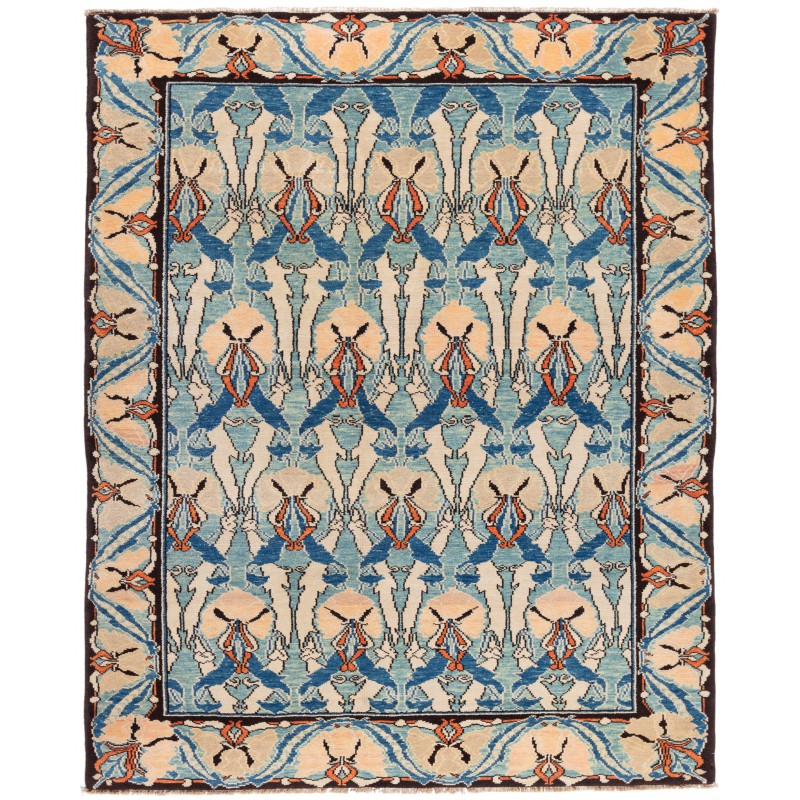
- Stock: 売り切れ
- Model: C50302
- サイズ: 155cm x 188cm
絨毯の源泉は、書籍「Arts & Crafts Carpets」(マルコム・ハズラム、デイビッド・ブラック、1991年)によるものです。この絨毯は、私たちのデザイナーが1880年代のイギリスでウィリアム・モリスのデザインを解釈して作成しました。1887年、イギリスの芸術家兼装丁師T.J. コブデン・サンダーソンは、新しいグループに「アーツ・アンド・クラフツ・エキシビション・ソサエティ」という名前を付けることを提案しました。その結果、彼は「アート・アンド・クラフツ」という用語を最初に使用し、この新興の運動に名前を付けたとされています。アーツ・アンド・クラフツ運動は、工場生産時代の製品の品質の低下から生じたものに触発されました。製造業における機械の台頭により、独自性や職人技の衰退が顕著になりました。これらの反産業改革派は、19世紀のイギリス社会から品質の低い「人工的な」品物を排除したいと考えていました。彼らは1851年の万国博覧会で展示された興味深くない品物の数々を目にし、独自性とユニークさのための運動を展開することにインスピレーションを受けました。
ウィリアム・モリスは、英国のデザイナーであり、社会運動家や作家としても活躍しました。モリスはテキスタイルアートと伝統的な生産方法の再生に火をつけたことで名声を得ています。1861年、モリスと少数のデザイナーが極めてファッショナブルなデザイン会社を立ち上げ、大いに成功しました。モリスはテキスタイル、書籍、家具、ステンドグラス、エリアラグなど、さまざまな媒体で作品を残しました。しかし、彼が最も記憶されているのは、彼がデザインした素晴らしい壁紙です。彼は自然界から多くのインスピレーションを得ました。モリスのインテリアデザイン作品を通じて、彼は部屋や空間を美しい木々が蔓延し、蔦や植物が織り成す草原に変えることを目指しました。モリスはかつて「どんな装飾も、それ自体を超える何かを思い起こさない限りは無駄である」と言ったことがあります。」
モリスは商業的にも大成功し、彼の作品はデザインとインテリアデコの世界で最も求められるものの一部です。彼はイギリスのテキスタイルアートとその生産方法をほぼ一人で復活させたとされています。また、モリスは機械製品に厳しい批判を行い、「ほとんどの文明人が作るほとんどの品物は安っぽく見え、偽りを装っている」と述べました。家は「信じられないほどのゴミで溢れている」とし、それらを巨大な焚き火に積み上げるべきだと提案しました。「機械による生産は、生活の条件として全く悪だ。」彼はアーツ・アンド・クラフツの最もよく知られたスタイルの一つを立案しました。それは、曲線的なパターンやシンプルでエレガントな花柄のデザインが特徴です。モリスはペルシャの絨毯を史上最高のものと考えていましたが、自身の手織り絨毯の製造にはより粗いトルコ(ギョルデス)結びを採用しました。当時、それらは1平方インチに25ノットの厚さで織られていました。モリス&カンパニーの絨毯は、英国庭園のデザインの絨毯のように、英国庭園のスタイリッシュなスタイルで描かれています。また、ドネゴールは19世紀後半に非常に望ましいアイリッシュラグの生産を開始しました。ドネゴールの絨毯は、英国の建築家C.F.A. ヴォイジーやギャビン・モートンによって主に作られました。手作りのヴォイジーの絨毯は通常、イングランド、スコットランド、アイルランドで織られています。ヴォイジーは対照的な形状を使用して単色のスペースを装飾する才能を持っていました。暗いアウトラインが彼の特徴的なパターンやケルトの絨毯デザインにドラマを加えました。最初のドネゴールの絨毯は密なウールの基礎上に手結びで作られました。ヴォイジーのデザインは多くの他のアーティストに影響を与え、類似した絨毯が多数現れるきっかけとなりました。この絨毯のデザインは私たちのデザイナーによって解釈され、柔らかい色合いが使用されています。
The source of carpet comes from the book Arts & Crafts Carpets, Malcolm Haslam, David Black, 1991. This carpet is interpreted by our designers with William Morris designs in the 1880s – in the United Kingdom. In 1887 English artist and bookbinder T.J. Cobden Sanderson, suggested that a new group be named the “Arts and Crafts Exhibition Society” As a result, he was the first to use the term “Art and Crafts” and also is credited with naming this new emerging movement. The Arts & Crafts movement was inspired by the degradation of product standards that resulted from the factory production age. The rise of machinery in manufacturing caused a noticeable decline in uniqueness and crafts. These anti-industrial reformers promoted economic advancement and social change. They wanted to eliminate poor quality and “artificial” items from 19th-century British society. They saw a plethora of uninteresting items on display at the Great Exhibition of 1851 and became inspired to launch a campaign for originality and uniqueness.
William Morris was an English designer, as well as an uplifting social activist and writer. Morris is credited with sparking the rebirth of textile arts and traditional means of production. In 1861, Morris and a small group of designers opened an incredibly fashionable design company that grew to be largely successful. Morris left behind works in many different mediums such as textiles, books, furniture, stained glass, and area rugs. But in the end, he is most remembered for the magnificent wallpapers that he designed. He got much of his inspiration from the natural world. Through his interior decor pieces, Morris set out to convert rooms or spaces into meadows with beautiful trees meandering, vines and plants. This concept of taking something industrial and man-made, and converting it into something natural is what William Morris meant when he once said: “-any decoration is futile… when it does not remind you of something beyond itself.”
Morris was a huge commercial success and his works are some of the most sought-after pieces in the world of design and decor. He is also credited with almost single-handedly reviving the British textile arts as well as their methods of production. Morris was also severely critical of machine-made goods, exclaiming, “Today almost all wares that are made by civilized man are shabbily and pretentiously ugly.” Houses were filled “with tons and tons of unutterable rubbish,” which, he suggested, should be heaped onto a gigantic bonfire! “As a condition of life, production by machinery is altogether evil.” He masterminded one of the most well-known styles of Arts & Crafts, recognizable by its twisting and arching patterns and simple, elegant floral design prints. Although Morris believed that Persian carpets were the greatest ever made, he adopted the coarser Turkish (Ghiordes) knot for his own hand-knotted carpet manufacture. They were woven at a thickness of 25 knots to the square inch at that time. Morris & Co.’s rugs are reminiscent of Persian garden design carpets in that they are smartly styled depictions of English gardens. Donegal also started producing highly desirable Irish rugs in the late 19th century. The Donegal rugs were predominantly created by English architects C.F.A. Voysey and Gavin Morton. The hand-crafted Voysey rugs are typically woven in England, Scotland, and Ireland. Voysey had a knack for using contrasting shapes to decorate flat monochromatic spaces. Dark outlines added a flair of drama to his signature pattern and Celtic rug designs. The first Donegal rugs were hand-knotted over a dense wool foundation. Voysey’s designs inspired many other artists, leading to the appearance of a large volume of lookalike rugs. The design of the carpet is interpreted by our designers, and soft colors are used for this carpet.
